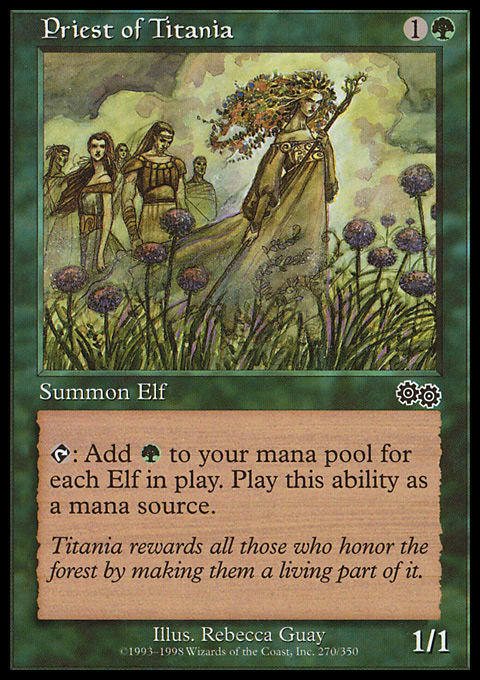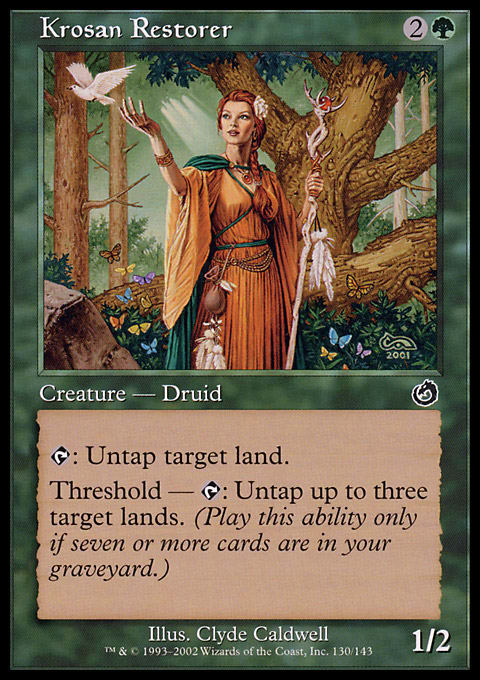In this experiment, we turn some kung-fu removal on its ear and use it to channel infinite mana.
Most of my articles feature oddball combinations of cards in sixty-card decks. Sixty-card decks offer the most opportunities for reliable combos, so I tend to take my ideas and form traditional casual decks around them—if readers like an idea but only play Commander, they can implement Pocket Combo concepts to stick some combo cards into a hundred-card Highlander stack.
Commander is the casual format I see played the most, it’s the casual format I play the most, and I expect it’s the casual format you readers play the most. So despite the fact that I usually write about sixty-card decks, whenever a new set comes out, the first thing I start thinking about is what new cards I can slot in with my existing commanders.
For this week’s article, the card I’ve selected is among those you’d least expect.
Well, I guess that may not be true considering I pretty much gave it away in the article title and have the card image floating off to the right. Anyway, Singing Bell Strike is a pretty efficient removal spell, though it comes saddled with a drawback. We can Encrust a potential blocker while pumping up our prowess creatures, but if our opponent pays ![]() , that creature becomes available for blocking for potentially the rest of the game—and it can even resume attacking if our opponent is willing to keep paying.
, that creature becomes available for blocking for potentially the rest of the game—and it can even resume attacking if our opponent is willing to keep paying.
However, that drawback can become the card’s upside in the correct circumstances. Imagine we have Arcanis the Omnipotent. If we Singing Bell Strike our own Arcanis, we essentially gain the superpower “![]() : Draw three cards.” Is that worth it? Maybe it is, and maybe it isn’t, but as you can imagine, there must exist activated tap abilities that make paying
: Draw three cards.” Is that worth it? Maybe it is, and maybe it isn’t, but as you can imagine, there must exist activated tap abilities that make paying ![]() for each iteration worthwhile.
for each iteration worthwhile.
Before we go into those, however, let’s take a look at one of my Commander decks.
Edric, Spymaster of Trest
I haven’t counted my Commander decks recently, but I think there are about fifteen, and I usually have two to six of them with me at a given time. I try to rotate them regularly, and the ones I play the most consist of some light combos, a lot of synergy, and generally just cards I like to play. One of them, for example, is a dedicated combo deck, and it almost always stays at home. The one I believe is the most powerful is my Edric, Spymaster of Trest deck. Since I’m not always trying to crush my opponents, but rather facilitate fun games for everyone, Edric also usually stays at home. (No, my deck probably wouldn’t stand toe-to-toe with the most powerful Commander decks, but because of the metagame I prefer to play in, it’s still a bit across the line.)
Edric works best with a lot of small creatures, as he can draw us a card each time one connects, and if we’re drawing more small creatures, we can cast them. The system only starts to break down when either we’re drawing way more cards that we can afford to cast or when someone casts a Wrath of God.
There are three primary facets to the deck. As Edric is an Elf and we’re planning to play a lot of small creatures, I naturally leaned toward a bit of Elf tribal. As we want to prevent Wrath effects, I next leaned toward playing a reasonable number of Counterspell variants to keep our army thriving. (I almost never counter something that wouldn’t destroy a bunch of my creatures.) And with so much efficiency and to close out games with what I was embracing as my strongest deck, the third primary facet is a suite of infinite combos.
Elf Spy Aggro ? Commander | Andrew Wilson
- Commander (0)
- Creatures (36)
- 1 Arbor Elf
- 1 Birchlore Rangers
- 1 Caller of the Claw
- 1 Chasm Skulker
- 1 Coiling Oracle
- 1 Elder of Laurels
- 1 Elvish Lyrist
- 1 Elvish Mystic
- 1 Elvish Pioneer
- 1 Elvish Scrapper
- 1 Hypnotic Siren
- 1 Kiora's Follower
- 1 Krosan Restorer
- 1 Llanowar Elves
- 1 Mystic Snake
- 1 Phantasmal Image
- 1 Priest of Titania
- 1 Prophet of Kruphix
- 1 Quirion Sentinel
- 1 Reclamation Sage
- 1 Sakashima's Student
- 1 Seedborn Muse
- 1 Seeker of Skybreak
- 1 Shardless Agent
- 1 Silhana Ledgewalker
- 1 Treetop Scout
- 1 Trygon Predator
- 1 Wellwisher
- 1 Wingcrafter
- 1 Wirewood Channeler
- 1 Wirewood Herald
- 1 Wirewood Hivemaster
- 1 Wonder
- 1 Zameck Guildmage
- 1 Ezuri, Renegade Leader
- 1 Nylea, God of the Hunt
- Spells (27)
- 1 Chord of Calling
- 1 Counterspell
- 1 Delay
- 1 Foil
- 1 Plasm Capture
- 1 Remand
- 1 Swan Song
- 1 Thwart
- 1 Tribal Unity
- 1 Unified Will
- 1 Withdraw
- 1 Aether Mutation
- 1 Overrun
- 1 Praetor's Counsel
- 1 Aluren
- 1 Burgeoning
- 1 Infinite Reflection
- 1 Pemmin's Aura
- 1 Singing Bell Strike
- 1 Squirrel Nest
- 1 Teferi's Veil
- 1 Aether Vial
- 1 Dolmen Gate
- 1 Expedition Map
- 1 Swiftfoot Boots
- 1 Umbral Mantle
- 1 Bow of Nylea
- Lands (36)
- 12 Forest
- 8 Island
- 1 Alchemist's Refuge
- 1 Breeding Pool
- 1 Cavern of Souls
- 1 City of Brass
- 1 Dryad Arbor
- 1 Hinterland Harbor
- 1 Lonely Sandbar
- 1 Mana Confluence
- 1 Mutavault
- 1 Reflecting Pool
- 1 Reliquary Tower
- 1 Simic Growth Chamber
- 1 Tranquil Thicket
- 1 Wirewood Lodge
- 1 Yavimaya Coast
- 1 Gemstone Caverns
Back to Singing Bell Strike
This new innocuous Khans of Tarkir common works with two of our deck’s game plans. First, as our deck wants to be aggressive early in order to build up a board presence and massive hand, Singing Bell Strike can disable early blockers, such as Solemn Simulacrum, to let us keep up the aggression. It may not seem exciting, but if it lets us get in two or three times when we otherwise wouldn’t have been able to, it becomes considerably better than a Divination.
But returning to the discussion from the beginning of this article, let’s cover what activated abilities Singing Bell Strike can facilitate going infinite with.
Wirewood Channeler and Priest of Titania – Both of these are extremely powerful cards that can potentially tap for a lot of mana. They’re restricted by the number of Elves we control, but that’s why we’re playing a lot of Elves. If we have at least seven, the ![]() of Singing Bell Strike is little enough that we can make that mana generation infinite to fuel our Tribal Unity, Nylea, God of the Hunt, Ezuri, Renegade Leader, Elder of Laurels, or the like. Wirewood Channeler also has Pemmin's Aura to let it go infinite, but since Singing Bell Strike doesn’t have a color restriction, Priest of Titania’s
of Singing Bell Strike is little enough that we can make that mana generation infinite to fuel our Tribal Unity, Nylea, God of the Hunt, Ezuri, Renegade Leader, Elder of Laurels, or the like. Wirewood Channeler also has Pemmin's Aura to let it go infinite, but since Singing Bell Strike doesn’t have a color restriction, Priest of Titania’s ![]() won’t be a limiter.
won’t be a limiter.
Gaea's Cradle – No, there’s no Gaea's Cradle in my deck, though if I owned one, it would be. And no, Singing Bell Strike can’t enchant a Gaea's Cradle. But with Seeker of Skybreak or Kiora's Follower, we’ll have a three-card, infinite-mana combo. Depending on our permanents, the same could be true with Nykthos, Shrine to Nyx.
Krosan Restorer – Like Seeker of Skybreak and Kiora's Follower, Krosan Restorer can untap a land. But unlike those two, if we have at least seven cards in our graveyard, Krosan Restorer can untap three lands instead. That means it makes infinite ![]() with Pemmin's Aura and Simic Growth Chamber. With Singing Bell Strike, we need three lands that tap for a total of more than
with Pemmin's Aura and Simic Growth Chamber. With Singing Bell Strike, we need three lands that tap for a total of more than ![]() , which isn’t possible in my Edric deck here. However, I just recently cut Elvish Guidance, which would enable such a synergy. Perhaps I’ll have to reconsider that cut.
, which isn’t possible in my Edric deck here. However, I just recently cut Elvish Guidance, which would enable such a synergy. Perhaps I’ll have to reconsider that cut.
No, Singing Bell Strike isn’t amazing new combo technology. It doesn’t do much that Pemmin's Aura didn’t already do better. But its versatility in allowing us to continue attacking—or even to shut down an opponent’s dangerous attacker—intrigues me. And I really appreciate the fact that the card can perform two different roles in this deck.
And More Combinations
Before I go, here are a few more combos to assemble while attacking in between Edric’s card-draw triggers.
Umbral Mantle – This is quite the unfair card. With only three Elves, an equipped Wirewood Channeler or Priest of Titania can become as large as we like, and with four Elves, we can make infinite mana as well—allowing us to move the Mantle around and grow any of our other creatures with tap activations as well.
Wellwisher and Squirrel Nest – With all the untap-related combos, these are two permanents that are quite nice to tap repeatedly. Wellwisher was known for its massive life-gain in its home Limited format, and it can do the same here. Life-gain isn’t what this deck is all about, but it can be quite useful when we can make it unbounded. Contrariwise, Squirrel Nest is always nice to have around when we draw cards for hitting opponents, even when it’s just for 1, and when we have Overrun effects around. When you name Squirrel with Tribal Unity, you can’t help but count that as a victory.
Seeker of Skybreak, Krosan Restorer, and Wirewood Lodge – This old combo is among my favorites, and all three cards fit in here. With threshold for the Restorer, we can use it to untap a Forest, the Lodge, and any land that produces at least ![]() . Seeker of Skybreak untaps the Restorer, and Wirewood Lodge with the Forest can untap the Seeker. Tap the third land for
. Seeker of Skybreak untaps the Restorer, and Wirewood Lodge with the Forest can untap the Seeker. Tap the third land for ![]() , and repeat. Of course, we prefer
, and repeat. Of course, we prefer ![]() and/or
and/or ![]() , but you get the point.
, but you get the point.
Combo Finish
This article was a little scattered—I shared one of my old Commander decks with you, covered several infinite combinations, and discussed a somewhat underpowered common (though it’s quite respectable in Limited!). But I hope you were able to look at an interesting card in new light while reinforcing what you probably already knew about why Edric, Spymaster of Trest is banned in Duel Commander.
Andrew Wilson
fissionessence at hotmail dot com





























